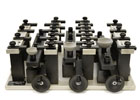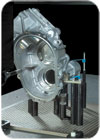
Custom fixtures are designed and built for a specific application such as a high-volume production part with complex geometry. Source: R&R Sales and Engineering
When purchasing a coordinate measuring machine (CMM) or vision machine, a commonly overlooked item is the fixturing. Fixturing is an important consideration as it is needed for holding various types of parts that need to be inspected.
Fixturing should be included at the time of the CMM or vision machine purchase so the machine can inspect parts as soon as it is set up. You would not buy a machining center without the right fixturing equipment for the application; the same holds true for a CMM or vision machine.
Fixturing should be the second priority, after the equipment itself. Without the purchase of fixturing at the time of the CMM or vision machine installation, too many CMMs or vision machines sit idle and unproductive because they are not efficient, particularly because there is no way to hold parts securely and repeatably.
Most CMMs do allow for threaded holes on the measuring surface to help hold and position parts on the machines. Unfortunately, the spacing of these holes can vary so much that they may not be useful, depending on the part size that needs to be held.
Vision machines have only a glass stage with even fewer holes, if any, around the stage perimeter itself. With these limited number of holes on the machines, it makes it difficult to secure the part and re-locate the part in the same position each and every time.
These machines generally do not come with any fixturing components that would enable the use of the threaded holes, unless purchased separately, so at that point the threaded holes are useless. This is where fixturing begins to play an important role.

Modular fixturing is normally less expensive than custom fixturing and has the flexibility to hold almost anything within a matter of minutes. Source: R&R Sales & Engineering Modular fixturing is normally less expensive than custom fixturing and has the flexibility to hold almost anything within a matter of minutes. Source: R&R Sales & Engineering
Application-Dependent
There are two types of fixturing for CMMs and vision machines: custom and modular. The best option depends on the application.Modular fixtures are a cost-effective method of fixturing most parts using the same fixture and components with the capability of presenting a part in the best attitude for the inspection equipment.
Custom fixtures are designed and built for specific applications, such as a high-volume production part with complex geometry.
Fixtures can hold any variety of part materials, shapes and sizes. Most commonly used modular fixtures start with a base plate that can accommodate many different part sizes depending on the application or the size of the CMM or vision machine used, whereas a custom fixture is more specific to the size of the part to be fixtured.
A modular base plate with threaded holes in a geometric pattern can allow more flexibility to hold any size, shape or type of part to be inspected, as opposed to to the limited number of holes on a CMM or vision machine. Some modular fixturing companies offer various thread sizes, hole spacing and components to hold the smallest most intricate part inspected on a vision machine up to the largest, heaviest parts that can be checked on a CMM.
There is no limit with modular fixturing as there are many different options of fixturing components used to elevate, locate and secure a part into position. Adjustable components are available that level or locate a part at the desired position to best access it for the necessary measurements.
In modular fixturing setups, various clamps and magnets can be used for securing a part. Modular fixtures can fixture parts and provide flexibility for quick changeover to another part in just a matter of minutes. There is no downtime waiting for a fixture to be designed and built. Modular fixtures can be used every step of the way from prototype work to production, a feat not so easily accomplished with custom fixturing.

There is no limit with modular fixturing as there are many different options of fixturing components used to elevate, locate and secure a part into position. Source: R&R Sales and Engineering
Getting Help
Some modular fixturing companies offer alphanumeric-labeled plates and components to document and record the fixture setup. One fixturing company provides software to model a part and fixture in 3-D modeling. This enables the operator to perform offline inspections and document the process as inconsistent fixturing methods can produce inconsistent results, meaning it is important to set a standard way of fixturing parts each and every time they are inspected. This makes the CMM and vision machine more accurate and consistent.Make sure when choosing a modular fixturing company that each of these fixturing components can be identified-for example, using part numbers. Correct, legible, long-lasting component identification improves fixture repeatability particularly when more than one operator is involved in the part setup or it has been some time since the part setup was previously done.
Looking into fixturing earlier in the process and deciding what type of fixturing will best fit the parts also gives the opportunity to allow for lead times. The more time and effort invested in the beginning, the better the return in the long run, since many custom fixtures can take months to design and build. Some modular fixturing companies do stock fixturing plates and components, but planning ahead for extra lead time if a specific plate size and mounting holes are needed to fit the machine will ensure that a company will not delay the introduction and start up of its inspection equipment.
Another important consideration when exploring which fixturing avenue to take is to look into the sources and capabilities each fixturing company offers. Is a combination of custom and modular fixturing needed? The more components and design options that a fixturing company offers, the more flexibility there will be to set up all of the parts using either modular or custom fixturing. If the fixturing provider is limited in its component selection or engineering capabilities, a company may run into difficulty holding complex parts.
The cost of fixturing also can be an issue. It should be addressed up front as many times the entire budget is spent on the machine and there is nothing left for fixturing. Why buy a machine if there is no fixturing budget to go with it?
Modular fixturing is normally less expensive than custom fixturing and has the flexibility to hold almost anything within a matter of minutes. It also can be documented, set up again, and used repeatedly as opposed to custom fixturing, which is specific to that part or application.
Custom fixturing can be more costly with engineering concepts, design and build of a fixture. It is necessary when a part has complex geometry, intricacy or orientation requirements that it be held in a way that allows for probe clearances and secure access in a particular way.
Using a fixturing company that has a sales and engineering staff familiar with the use of touch probes and backlighting is critical to fixturing success. In the case of modular fixturing, the provider can assist in ordering the correct fixturing base plate and components. When working with custom fixturing provider, they will be able to design and build a fixture the right way the first time. They know up front the limitations and interferences of CMM and vision machines capabilities.
Whether purchasing a CMM or vision machine, keep in mind the success and payback from the inspection equipment comes faster if fixturing is a priority that is not missed or overlooked. The right fixturing-modular or custom-is the key to getting complete success and production from the inspection equipment.
Fixturing can help a company make quality products as the part will be held securely and consistently the same way on the fixture each and every time, gaining valuable inspection results and success with inspection equipment.Q
Quality Online
For more information on fixturing, visitwww.qualitymag.com to read the following:“Fixtures Meet Need for Flexibility”
“Fixturing Presents Quality Products”
“Simplicity Key to CMM Fixturing”